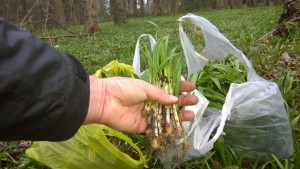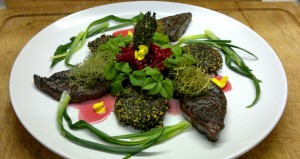Few-Flowered Leek – Identification, Distribution, Edibility
Allium paradoxum, AKA Few-flowered garlic, few-flowered onion
Also discussed here: three-cornered leek, allium triquertum.
- Identification – 3 – 20-40cm long, 2-25mm wide lanceolate leaves, looking quite like spring onions. Small white drooping flowers and clusters of bulbils. Often carpeting large areas.
- Edibility – 4 – A delicious, fresh taste of spring
- Distribution – 3 – More common in W Scotland and N England
- Habitat – Parks, hedgerows and woods, often in (sub)urban areas.
- Season – December – April
If you come across a plant that reminds you of wild garlic, but has narrower leaves and less of a garlic smell, you may have found wild leeks. These aren’t the hulking great Frankenstein leeks you might expect to find in shops and gardens, but something tender and elegant, much more closely resembling spring onions. They start to grow between November and February.
Be aware that crocuses, snowdrops, daffodils and bluebells grow around the same time and can be mixed through wild leek colonies. They are all toxic and could make you quite sick. If in doubt, crush them and smell for the distinctive sulphury kick of allium or wait for the distinctive flowers to appear. Snowdrops have a bluer shade of green!

Wild leeks can carpet vast areas, from which they can be efficiently harvested with a clear conscience
Few-Flowered Leek can carpet large expanses of wet woods and parkland, especially along river banks. As its names suggests, it has rather fewer flowers than one might expect from such a vigorous plant, but it makes up for this by producing lots of bulbils which are good to eat in similar way to wild garlic seeds. They have a mostly northern distribution and are common in Scotland, especially coastally. If you find something similar, but with lots more hanging white flowers and a distinctly triangular cross-section, you may have found 3-cornered leek (allium triquertum), which is common in parks, hedgerows and waste ground in the south of the UK.
Both these wild leek varieties can be used in the same ways as you might wild garlic. Few-flowered leek is considered so invasive that it is illegal to spread it in the wild, though I would happily have it in my garden instead of grass!
Wild leeks can be used in place of spring onions, cooked or raw. Remember, as with all alliums the pungent flavour comes from highly volatile oils that are lost when heated. If you want to make it into soup, use it as a base by all means, but be sure to blitz some fresh leaves through at the last minute. Few flowered leek is closely related to wild garlic (allium ursinum) and as you might expect, can be used in similar ways – only without such a strong garlic flavour. Pesto, hummus, salads and sauces are all great, but my favourite thing is to lacto-ferment it – either unadulterated or with nam pla, chilli and ginger to make a kimichi style ferment.
Related pages:




8 Comments
Thanks so much… I have masses of what I thought was wild garlic, but I now know it is the tri-flowering leek.. such a relief to finally identify it.
Wow thanks for that, found an abundance on the entrance to woburn golf club. Happy with my find but still hunting for the elusive wild garlic, any body know where I could find some near the woburn area????
Hi. I came across the few-flowered leek while walking in the scottish borders. It took me a few days to discover ehat it was. Thanks to your web page.
Few flowered leek is Unfortunately a menace in my garden
I have tons of these In my garden. When I mow the grass it stinks like garlic bread. And no. I have not tried eating it. It spreads all over
If you can’t beat it, eat it?
Very helpful. Based in SW Autsralia where it is in huge ..swathes..Better start eating!
Found a massive patch of this in my walk tonight. Pretty excited! It’s my first forage that I’ve confidently identified thanks to your page.